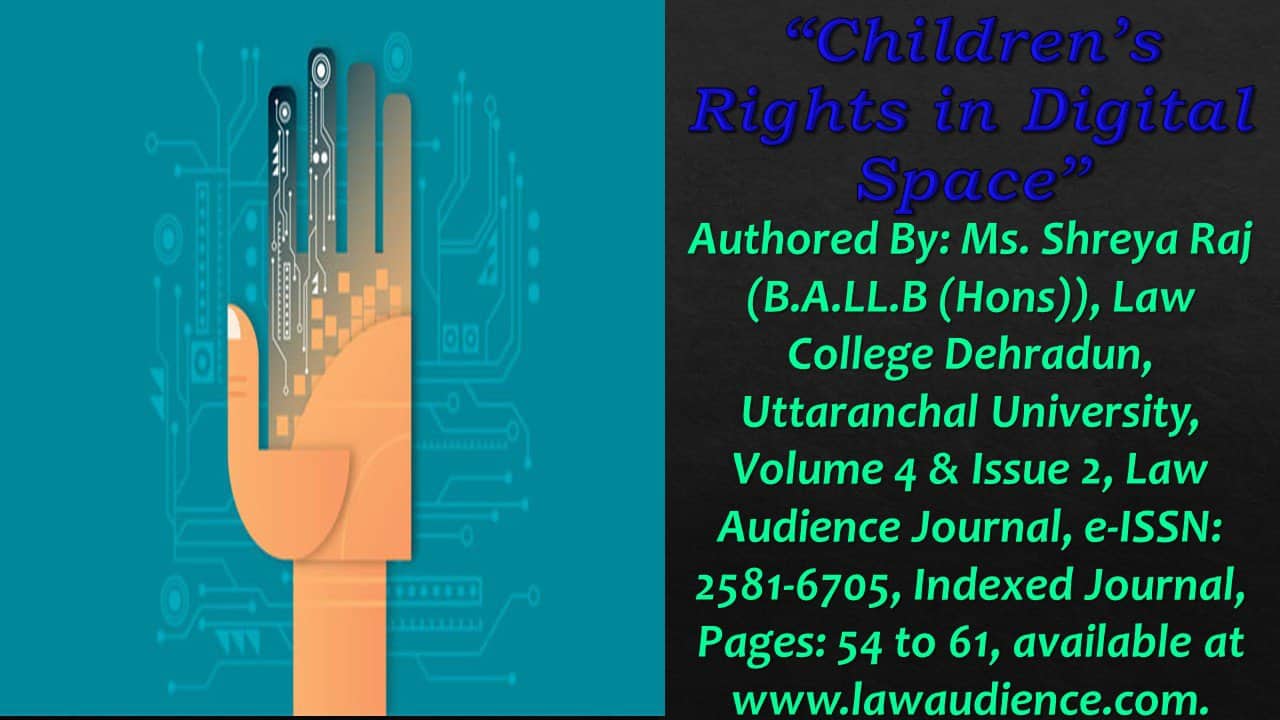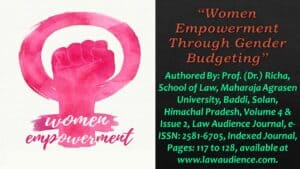Click here to download the full paper (PDF)
Authored By: Ms. Shreya Raj (B.A.LL.B (Hons)), Law College Dehradun, Uttaranchal University,
Click here for Copyright Policy.
ABSTRACT:
“In the era of technology-based world, almost every second activity is associated with internet. People’s life has been becoming inseparable from internet and digitalized. Since last year this dependency over internet becomes more affixed due to pandemic. Meanwhile, if something becomes more adhered to digital world, then that is online based primary to higher education of students. As per United Nations International Children’s Emergency Fund (UNICEF)[1], one in three internet users is a child, meaning there by, we can estimate one third digital space populations consist of children only. According to Internet and Mobile Association of India, 71 million between the age group of 5-11 Years are active users and 472 million between the age group of 5-18 years are total internet users in India. They are victimized of Cyber threats, data theft, cyber bullying, sexual harassment etc.
UNICEF in report of India’s Child Online Protection 2016 emphasizes on increasing cybercrimes in India. So advance working of children’s rights protection is direly needed because children’ rights in digital age is tantamount as adults’ right. Teenagers spend their substantial portion of time on internet for education, socialization, entertainment, communication, trainings etc. No doubt digital media gives vast opportunity, different learning platform, vast exposure, various developments handles, socialization ways, and communication media on internet.
Where they are being developed till their full potential, on the other hand it also exposes children to risk of exploitation, cyber bullying and sexual and mental abuse by adult users. In digital space, dynamic kind with people of mala fide intension also exist in cyber world where they are on the other side sitting to execute their anti-social activity against children. These bad elements pollute digital environment by commercial exploitation, cyber bullying, exposure to extreme pornography, hate or self-harm materials, image sharing, live streaming of child sexual abuse which leads to unhealthy and terrific environment for children. Every action has consequences, but is doesn’t mean that we stop doing actions or halting children from accessing the internet, taking benefits of digital age, cutting them off from grabbing dynamic opportunities. Instead of that we have to introduce digital literacy, aware the children about their rights and how to be safe and protected from unlawful and anti-social activities”.
I. CHILDREN’S RIGHTS IN DIGITAL SPACE:
Children are the one third internet users in digital world, who are exposed to various digital misfortunes which don’t lead to children friendly environment anymore. So, they need to know that like adults, they too have basic rights to be protected, be safe, access health and social friendly environment. Some of the rights are given below:
- Right to education
- Right to privacy
- Freedom from exploitation and abuse
- Freedom of expression
- Right to remedy from unlawful activity
- Right to Provision of resources necessary for survival and development to their full potential
- Right to protection from a wide array of threats
- Right to participation to enable children to engage, play active part in a society.
United Nation has adopted and ratified ‘The Convention on the Rights of the Child’ by General Assembly which makes signatory states to be obligatory to follow and implement the provisions of the convention. Article 13 of this convention provides that child shall have right to freedom of expression which includes freedom to seek, receive and impart information and ideas of all kinds, regardless of frontiers, either orally, in writing or in print, in the form of art, or through any other media of child’s choice. The exercise of this right may be subject to certain restrictions, but these shall only be such as are provided by law and are necessary for respects of the rights or reputation of others or for the protection of national security of public order, or of public health or morals. Article 16 guarantees that ‘no child shall be subjected to arbitrary or unlawful interference with his or her privacy, family, home or correspondence nor to unlawful attacks on his or her honor and reputation and the child has the right to the protection of the law against such interference or attacks’.
II. INDIA’S POSITION IN COMPARISON WITH OTHER COUNTRIES:
General Data Protection Regulation (GDPR) is toughest privacy and security law in the world under which countries try to implement data privacy laws through their legislation, United States of America enacted the law Children’s Online Privacy Protection Act (COPPA) which empowers Federal trade Commission to make and enact regulations for the protection of the children with the online privacy. It regulates the collection of data from children who came under the age group of 13. Similarly, The Republic of China made laws i.e., Cyber Protection of Children’s Personal Information for the protection of the online privacy of the children under which Network operators shall have to maintain the righteousness, definite purpose & guaranteed security while collecting, transferring or disclosing any kind of data. It is applicable on the children under the age group of 14. Operator obtains parental consent before collecting, using and transferring any kind of child personal information.
II.I INDIA’S POSITION:
Now, in India Children between the age group of 5 to 18, 472 million children who are prone to cybercrimes are not given any protection. After the landmark judgment Justice K S Puttaswamy v Union of India[2] Right to privacy has been declared as fundamental right under Article 21 Right to life and Personal Liberty but it is not protected yet under any legislation. Under Justice B.N. Srikrishna chairmanship an Expert Committee constituted in 2017, inter alia, to deliberate on a data protection framework for India, and to suggest a draft data protection bill for the country. Thereafter Parliament introduced The Data Protection Bill 2019 in December 2019. Unfortunately, there has been more than one and half year, but this bill is passed by neither of the houses. Whereas about 70 plus bills have been introduced in and passed by houses but people’ liberty kept on abeyance and left out as a general bill. Children are the one third internet users in digital world, who are exposed to various digital misfortunes which don’t lead to children friendly environment anymore. Along with right to privacy, others’ rights like Right to education, Right to privacy, Freedom from exploitation and abuse, Freedom of expression, Right to remedy from unlawful activity, Right to Provision of resources necessary for survival and development to their full potential, Right to protection from a wide array of threats, Right to participation to enable children to engage, play active part in a society are also infringed.
India being the signatory state to UN is obligatory to implement the Article 13 of this convention which provides that child shall have right to freedom of expression which includes freedom to seek, receive and impart information and ideas of all kinds, regardless of frontiers, either orally, in writing or in print, in the form of art, or through any other media of child’s choice and Article 16 guarantees that ‘no child shall be subjected to arbitrary or unlawful interference with his or her privacy, family, home or correspondence nor to unlawful attacks on his or her honor and reputation and the child has the right to the protection of the law against such interference or attacks’. Although Data Protection Bill 2019 is pending in Parliament so law under this bill is not functional but India has few laws for the protection children from crime in cyber world i.e.
The Information Technology Act 2000 (21 of 2000), The Protection of Children from Sexual Offences Act, 2012 (POCSO) (32 of 2012). Section 11 of The Protection of Children from the Sexual Offences Act 2012 defines the term Sexual Harassment, specifically section from 11(iii) to 11(vi) talks about sexual harassment done through electronic means. Section 11 says a person who shows any object to a child in any form or media for pornographic purposes, or repeatedly or constantly follows or watches or contacts a child either directly or through electronic, digital or any other means, or threatens to use, in any form of media, a real or fabricated depiction through electronic, film or digital or any other mode, of any part of the body of the child or the involvement of the child in a sexual act; or entices a child for pornographic purposes or gives gratification therefor is said to commit sexual harassment. Section 12 of the Act 2012 provides the punishment for the sexual harassment with imprisonment of either description for a term which may extend to three years and shall also be liable to fine. Chapter III of the Act 2012 separately prohibits the using the child or children from pornography purpose and also provides the punishment. Section 13 says that any person, whoever, uses a child in any form of media like programme or advertisement telecast by television channels or internet or any other electronic form or printed form, whether or not such programme or advertisement is intended for personal use or for distribution, for the purposes of sexual gratification, shall be guilty for the using child or children for pornography purpose.
Section 14 of the Act 2012 provides the punishment for the same which is imprisonment for a term which shall not be less than five years and shall also be liable to fine and in the event of second or subsequent conviction punishment would be the imprisonment for a term which shall not be less than seven years and also be liable to fine, if whoever is found to use child or children for the purpose of pornography. These are some provisions for the children against sexual offences but they are not anywhere effective for other offences against children. So, legislature needs to take action in this regard and make new sufficient laws for the protection of children’s right in cyber world.
III. EMERGING ISSUES AND CHALLENGES:
There is no rose without a thorn, similarly digital space consists of both good and evils. Gradually as technology is getting advanced, at the same time troubles are getting tougher.
- Children are growing; they share their information from personal to educational data on internet. Now a days children used to share and post their extensive information and photos of personal nature which are always available online once it is shared. Those shared information might be provided for educational purpose but people, who are able to access, may commercially misuse that information in future, which became a major concern to right to privacy of children.
- Perpetrators, around the world, are looking for the children to sexually abuse and harass them by sharing violent and sexual contents. It is not stopped here; children are being trapped into human trafficking. Since last year as pandemic starts, case of human trafficking has been increasing. The experts of Committee on the Elimination of Discrimination against women (CEDAW) highlighted those women and girls continue to be the most victims of trafficking across the world through social media and chat apps to recruit trafficking victims during Covid-19.
- As time passes, traditional way of communication is getting transformed into digital way of communication. Children spend their substantial time on internet, using social media more than 2 hours in a day results mental poor health and leads to frustration, children don’t find social interaction, deprived of social gatherings, unable to share feelings, emotions, and started feeling low, cyber bullied and finally symptom of suicidal tendency arises. As per the study it is found that suicide is the second leading cause of death among youths. Due to anxiety, frustration, mental disturbance, mental poor health, mental distress, children again try to find entertainment, joy, happiness, they explore different-different sites. And perpetrators looking for this kind of children target them and children become victims of these traps. Many online games existing on the internet which aid children to commit suicide in the grab of getting out of the sorrow and grief. In year 2016, the game ‘Blue Whale Challenge’ was the one of the dangerous games in which one has to complete all levels of the game in 50 days and final day one has to lose his life to complete the challenge. In this way, more than 130, deaths had been reported. It is not the only way to push youths into troubles but there are other ways to catch.
IV. SOLUTIONS:
For the protection of children’s rights in the digital space, every age of people needs to understand the fundamental of solutions.
IV.I DIGITAL LITERACY:
Nowadays, education is not restricted to physical mode only but also online mode too. So, association and involvement with internet exposes many threats to privacy of children. As per article 13 of Convention on the Right of the Child, every child has right to freedom of expression, right to seek and impart information. So, with availing this right child must be aware with their right and risks and what to do about them.
IV.II LEGAL ACTION AND APPROACH:
Article 19 of Convention on the Right of the Child, obligates that states parties shall take all appropriate legislative, administrative, social and educational measures to protect the child from all forms of physical or mental violence, injury or abuse, neglect or negligent treatment, maltreatment or exploitation, including sexual abuse, while in the care of parents, legal guardian or any other person who has the care of the child. Such protective measures should, as appropriate, include effective procedures for the establishment of social programs to provide necessary support for the child and for those who have the care of the child, as well as for others forms of prevention and for identification and as appropriate, for judicial involvement.
IV.III CHILDREN FRIENDLY ENVIRONMENT:
We need to endeavor to create a clean and children friendly environment so that they may not get exposed to any unlawful harm and anti-social elements. State agencies needs to establish or increase the surveillance and monitoring tools to keep an eye on un-authoritative and unlawful activity which may be dangerous to children.
IV.IV STRONG LEGISLATION:
Countries like United States of America and China have legislated the laws for the protection of children’s right of privacy which help to mitigate the crimes against children in space but India doesn’t have any particular law to protect the Right to Privacy. So, each country should have a specified law to deal with such issue and which countries already have, then they should check the implementation and effectiveness of the law.
V. CONCLUSION:
As we are at the edge of the fast development in the field of science, we can say that everything is somewhere connecting with cyber world as well as cybercrimes. So, we need to have strong legislation to protect the people’ right to privacy in the cyber space, as we know we have end number of laws in physical space for the protection. But it is not the same in the case of cyber world where millions of people directly or indirectly connected with good or bad elements both. With increasing problems and harm to children, international organizations and signatory state are striving to tackle these growing problems with different steps.
Therefore, it is the need of the hour for the Parliament to pass the Data Protection Bill 2019 so that Right to Privacy under Article 21 of the Constitution of the India can be protected. UN Rights Committee has instructed social media platforms to bring big data and artificial intelligence to eliminate trafficking among girls and women. Indian government has also initiated the Cyber Crime Prevention against Women and Children (CCPWC)[3] which aims to handle cybercrimes against women and children in the country.
Thus, in future, more persuasive and effective laws and programs need to be taken along with strong implementation of ongoing and coming programs.
Cite this article as:
Ms. Shreya Raj, “Children’s Rights in Digital Space”, Vol.4 & Issue 2, Law Audience Journal (e-ISSN: 2581-6705), Pages 54 to 61 (2nd August 2022), available at https://www.lawaudience.com/childrens-rights-in-digital-space/.
Footnotes & References:
[1] ohchr.org>English>News and Events>Protecting Children’s right in the digital age.
[2] Justice K S Puttaswamy v Union of India (2017) 10 SCC 1.
[3] www.mha.gov.in.




